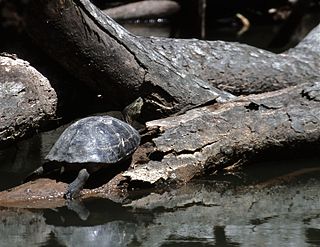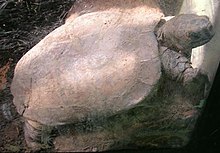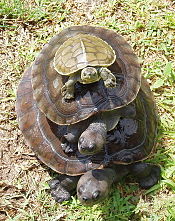
The Bolson tortoise, also called the Mexican giant tortoise or yellow-margined tortoise, is a species of tortoise from North America. Of the six North American tortoise species, it is the largest, having a carapace length of about 46 cm (18 in). It lives in a region of the Chihuahuan Desert known as the Bolsón de Mapimí, which is located in north-central Mexico.

The Burmese star tortoise is a critically endangered tortoise species, native to the dry, deciduous forests of Myanmar (Burma). It is close to extinction in Myanmar, as it is eaten by the native Burmese.

Heosemys is a genus of freshwater turtles in the family Geoemydidae. The genus Heosemys was split out of the related genus Geoemyda by McDowell in 1964.

The giant Asian pond turtle inhabits rivers, streams, marshes, and rice paddies from estuarine lowlands to moderate altitudes throughout Cambodia and Vietnam and in parts of Laos, Malaysia, Myanmar and Thailand.

The spiny turtle is a South-East Asian turtle species. It inhabits lowland and hill rainforest, usually dwelling in the vicinity of small streams in hill areas up to 1,000 m above sea level. It is found in Brunei, Indonesia, Malaysia, Myanmar, the Philippines, Singapore, and Thailand.

The Arakan Mountains, natively referred as Rakhine Yoma and technically known as the Southern Indo-Burman Range, are a mountain range in western Myanmar, between the coast of Rakhine State and the Central Myanmar Basin, in which flows the Irrawaddy River. It is the most prominent of a series of parallel ridges that arc through Assam, Nagaland, Manipur, Mizoram and Myanmar.

The keeled box turtle is a species of turtle in the family Geoemydidae. The species is endemic to Asia.

The Cochin forest cane turtle, also known as Kavalai forest turtle, forest cane turtle or simply cane turtle, is a rare turtle from the Western Ghats of India. Described in 1912, its type locality is given as "Near Kavalai in the Cochin State Forests, inhabiting dense forest, at an elevation of about 1500 feet above sea level". Only two specimens were found at that time, and no scientist saw this turtle for the next 70 years. It was rediscovered in 1982, and since then a number of specimens have been found and some studies have been conducted about its phylogeny and ecology.

The yellow-headed temple turtle is a large species of turtle in the family Geoemydidae. The species is native to Southeast Asia.

The black-breasted leaf turtle, also commonly called the Vietnamese leaf turtle or the black-breasted hill turtle, is a species of turtle in the family Geoemydidae. The species is endemic to Southeast Asia.

The Burmese roofed turtle is one of six turtle species in the genus Batagur of the family Geoemydidae. It is a freshwater turtle endemic to Myanmar and was thought to be extinct until rediscovered in 2002. Less than 10 mature individuals were known by 2018.
The Sulawesi forest turtle is a critically endangered species of turtle in the family Geoemydidae. The species is monotypic within the genus Leucocephalon. It is endemic to Sulawesi in Indonesia.

Siebenrockiella crassicollis is a freshwater turtle endemic to Southeast Asia. It is one of two species classified under the genus Siebenrockiella in the family Geoemydidae.
Rakhine Yoma Elephant Range is a protected area in Myanmar's Rakhine Yoma mountains, covering about 1,756 km2 (678 sq mi) of evergreen and mixed deciduous forest at an elevation of 20–1,270 m (66–4,167 ft).
The Daingnet people, also known as the Thetkama people are an ethnic group indigenous to northern Rakhine State, Myanmar. According to their own internal census in 1995 they numbered about 60,000. In 2011, the number is estimated to be around 80,000. From appearance they are indistinguishable from the Rakhine people; however, the Daingnet people have a distinct language and culture. Ethnically, they are closely related to the Chakma people of Bangladesh and Northeast India. The languages of the Daingnet and Chakma people are mutually intelligible. Daingnet people are one of 135 ethnic groups officially recognized by the Myanmar government as indigenous to Myanmar. Daingnets are one of the Tibeto-Burman tribes. Genetically they are closely related to the Tibetans, Burmans and Rakhines.

The Jalisco mud turtle is a species of mud turtle in the Kinosternidae family endemic to Mexico. It is found in Colima and Jalisco. They live in freshwater habitats like swamps or quiet rivers. Jalisco mud turtles reproduce oviparous, meaning the eggs hatch after the parent has laid them. Population size is unknown; there have been less than 20 individuals seen in the last twenty years. The mud turtle is said to be adapted to aquatic habitats, meaning that a population decline is then expected due to habitat fragmentation.

The Mexican mud turtle, is a species of mud turtle in the family Kinosternidae. Endemic to Mexico, it is found in Aguascalientes, Colima, Durango, Guanajuato, Guerrero, Hidalgo, Jalisco, Michoacán, México, Morelos, Nayarit, Oaxaca, Puebla, Queretaro, San Luis Potosí, Sinaloa, Sonora, Tamaulipas and Zacatecas, where they inhabit moist environments, such as shallow ponds, lakes, rivers or intermediate temp. tropical forest areas.
The African dwarf mud turtle is a species of turtle in the family Pelomedusidae. It is endemic to Africa : in Angola, the Democratic Republic of the Congo, Malawi, and Zambia. These mud turtles are the smallest of all African turtle species, “Nanus” which they are referred to are one of the 3 smallest turtle species in the world. The other two are Stink Pot Musk and Muhlenberg's Bog Turtles. All 3 species barely reach 4 inches as full grown adults. Like many of the world's chelonians, Pelusios castaneus has the potential to live a long life. Reports typically suggest more than 50 years in captivity for this species.

Centrochelys is a genus of tortoise. It contains one extant species and several extinct species:
Kalyar Platt is a Burmese herpetologist and turtle conservationist. She is the director of the Myanmar Program of the Turtle Survival Alliance and oversees conservation, breeding and reintroduction projects for some of Southeast Asia's rarest turtle species. She formerly worked for Wildlife Conservation Society and earned her PhD from Bangkok's Chulalongkorn University in 2007.


















